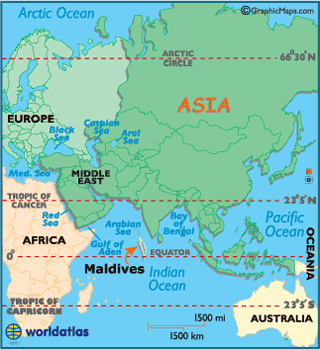With climate change, there are many relationships that are understood, and many others that are not. Dr. Veerabhadran Ramanathan from The Scripps Institute in San Diego has spent the last fifteen years in the Maldives, a nation south of India that is comprised of over 1,200 islands, studying the relationship between air pollutants, cloud formation and air temperature.
The Maldives are a great location for such an experiment because during the months of November through March, the country experiences its dry season with respect to the monsoon, and pollutant heavy air can be seen traveling from thousands of kilometers away from countries like India and Pakistan. Furthermore, the island nation has a low elevation and is extremely sensitive to changes in sea level rise.
Through the research, Ramanathan and his colleagues discovered that these pollutants are primarily composed of black carbon soot that comes from the burning of fossil fuels and biomass. With the longevity of the research, they were able to understand that there is a strong heating effect of these pollutants. But black carbon soot affects more than air temperature – it destroys millions of tons of crops annually and causes human health concerns. The good news is that this type of emission is easy to reduce due to the face that its lifespan in the atmosphere is short.
If these types of pollutants are reduced quickly, the long-term negative effects of climate change can be reduced by nearly 50% in the next 20-30 years. With Ramanathan’s research, The Climate and Clean Air Coalition (CCAC) was established. The CCAC is focusing on the reduction of short lived pollutants by nearly one third to protect and improve human health and agriculture.
And while the relationship between black carbon soot and warming is better understood, and has recently been presented by the International Global Atmospheric Chemistry Project, the affect the black carbon has on clouds and the type that form is still unknown. Further research is necessary to understand the feedback between black carbon affected clouds and climate change.
Suggested activity: If you’re a GLOBE school in an area that sees seasonal fluctuations in air quality, you can perform your own research study to see the affect that air pollution has on your local temperature, cloud type and cloud cover. Start by taking air temperature, cloud clover, cloud type and aerosol measurements and enter them into the GLOBE database. Then as your database grows, start to examine the relationships that exist between the variables. Then, be sure to tell us about it. You can share your future research plans with us through a comment, email or on our Facebook Page. For more information on Ramanathan’s research, watch this video.
-Jessica Mackaro



Hello !
I saw your post , searching for ECO articles , and i have a question ! Can i use your image on my site ?
I’m from romania an i wan to explain on my site about Aerosol Proces in Clymate Sistem
Thank you !
Greetings – We used the image from the American Geophysical Union, giving them the credit. If you would like to use the image, we suggest you contacting them.
Thank you for contacting us, and reading our blog.
the article is interesting but map has a strange proportion…